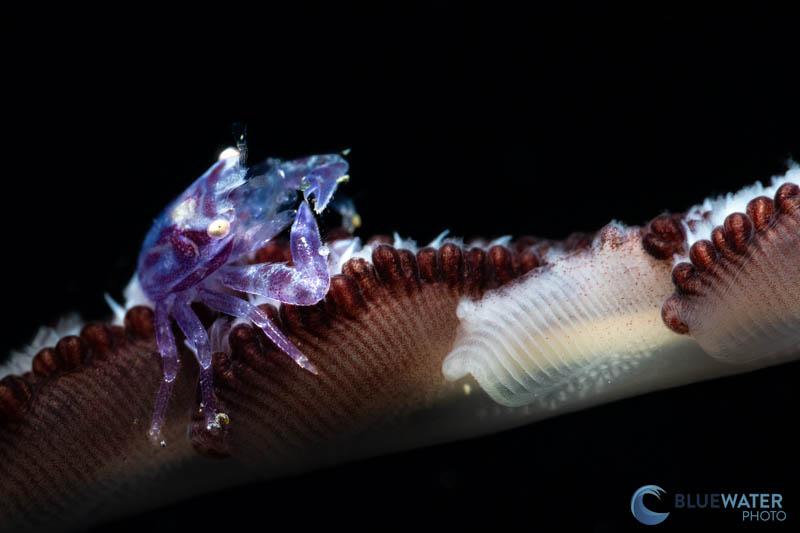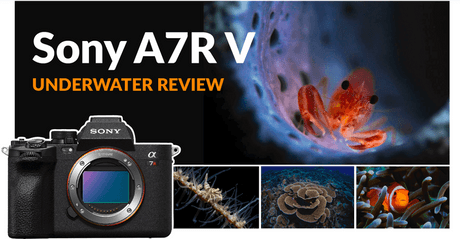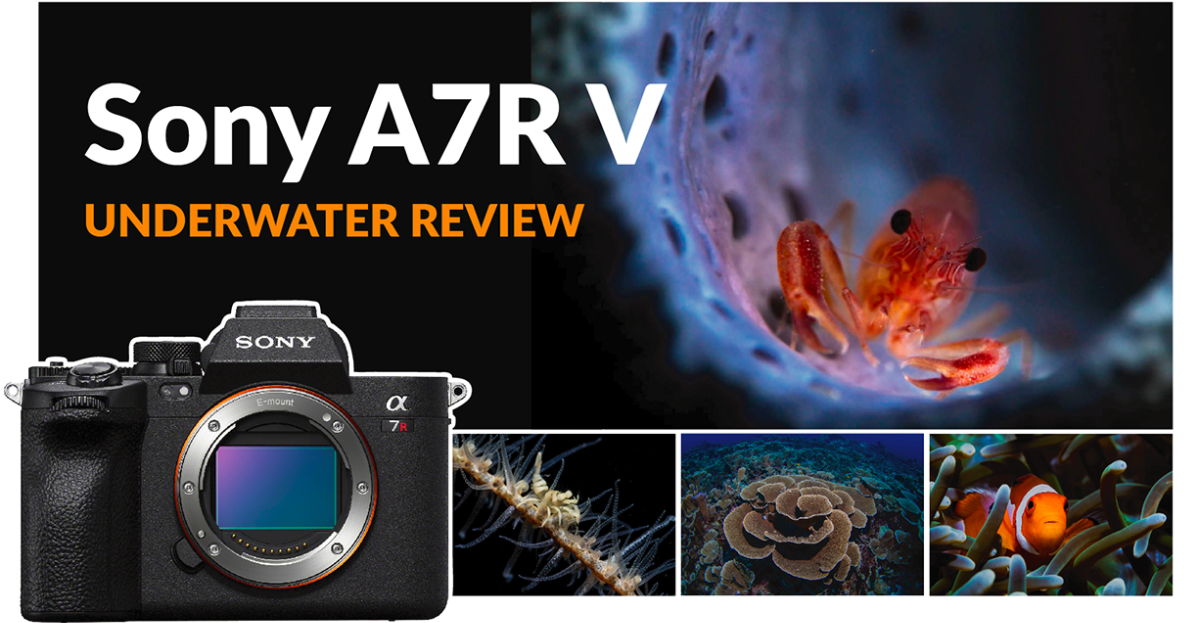Sony A7R V Underwater Review
Posted by Nirupam Nigam on March 24th, 2023
The Sony A7R V is this year's superstar underwater camera. As a worthy successor to the A7R IV, the A7R V is Sony's answer to the market-dominating Canon EOS R5. With a similar price point to the Canon R5 at $3898 for the body, the Sony A7R V features the same ultra-high resolution 61 megapixel sensor that is found in the A7R IV. Notable upgrades to the camera include improved 5-axis in-body image stabilization (now up to 8 stops of correction), 8K/24p & 4K/60p video recording, and a new AI autofocus processor. These features position the camera in the high-end professional market without the exorbitant price point of a flagship camera like the Sony A1 or Nikon Z9. So do the new specs live up to the hype? Read our Sony A7R V underwater review below, and you'll find out! Need an underwater housing for the Sony A7R V? Check out our Sony A7R V underwater housing guide!
A Trip of A Lifetime with the Sony A7R V
Fortunately for me, I was able to bring this incredible camera on the trip of a lifetime - our Bluewater underwater photoworkshop to Raja Ampat, Indonesia. It had been seven years since I had last been in Indonesia. Being back in such a beautiful location reminded me how photographic prowess and subject matter take a sharp precedence over the gear you have in your hand. As long as you are in the right place at the right time with the right knowledge, any camera will do the job. That said, it certainly helps to have a Sony A7R V.
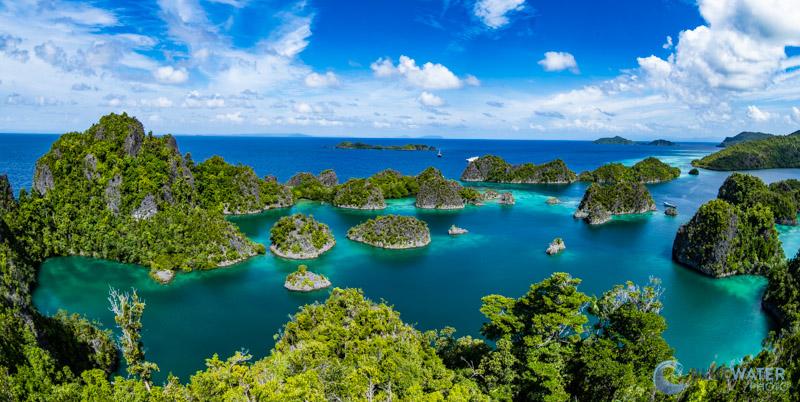
Raja Ampat photographed topside with the Sony A7R V and the Canon 8-15mm fisheye lens with the Sigma MC-11 adapter
Over the course of dozens of dives throughout Misool, the Fam Islands, Batanta, and Central Raja, I had the opportunity to really push this new camera to its limits. Huge stands of soft coral gave me the opportunity to try out the Canon 8-15mm fisheye lens with the Sigma MC-11 adapter. Quick schools of fish allowed me to see just how fast the new AI autofocus processor could be. A storm in Batanta kept us relegated to muck diving sites - giving me the perfect opportunity to push the Sony 90mm macro lens and Kraken KRL-05s +13 diopter to their limits.
But most importantly, I had the opportunity to learn from our guests and get a new feel for what underwater photographers need in a camera. Many of our shooters were Sony shooters. It was a unique situation where I could compare the A7R V to other top cameras like the Sony A7R IV and the Sony A1. Right off the bat, I could see that the Sony A7R V did not overheat when shooting 4K/60p video, unlike the Sony A1, and the A7R V did indeed give me faster autofocus than the Sony A7R IV. So let's take a look at all the reasons why the Sony A7R V is a solid choice for all underwater photo and video shooters...
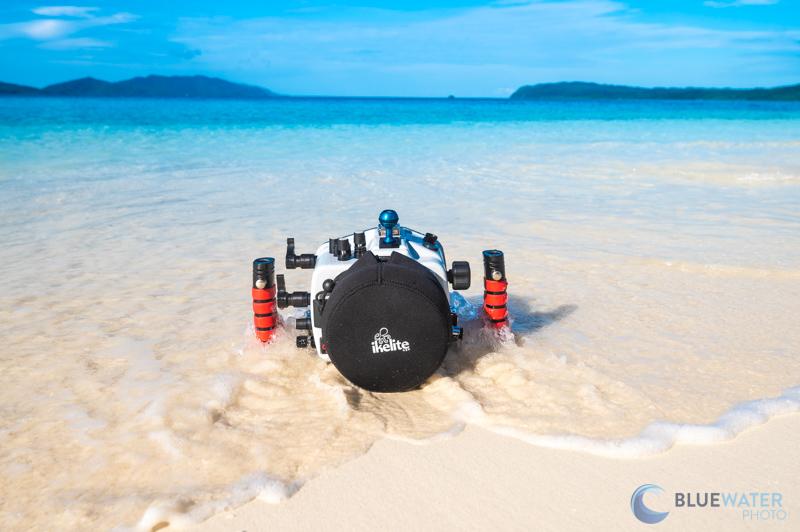
The Sony A7R V in an Ikelite A7R V housing on a white sand beach in Raja Ampat, Indonesia
Jump to a Section
Specifications | Key Features | Sony A7R V for Underwater Photo & Video
Who Should Buy? | Underwater Housings
Underwater Lenses | Conclusions
Sony A7R V Specifcations
- 61 megapixel full-frame Exmor R BSI CMOS Sensor
- Dual Bionz XR Processors
- 8 stops of 5 axis in-body image stabilization (IBIS)
- 10 fps burst shooting (compressed RAW)
- AI based real-time tracking AF system with a dedicated AI processor
- Autofocus in lowlight down to -4EV
- 8K/24p and 4K/60p (10-bit 4:2:2) video recording
- 4K 16-bit RAW video can be recorded to an external recorder
- S-LOG3, S-Log2, S-Cinetone picture profiles available
- 3.2" 4-axis multi-angle touchscreen
- 9.44 million dot EVF with a 120 fps refresh rate
- 1/250 sec shutter sync speed (with strobes)
- Dual CFexpress type A/UHS-II SD card slots
- Size: 131 x 97 x 82mm
- Weight: 723 grams
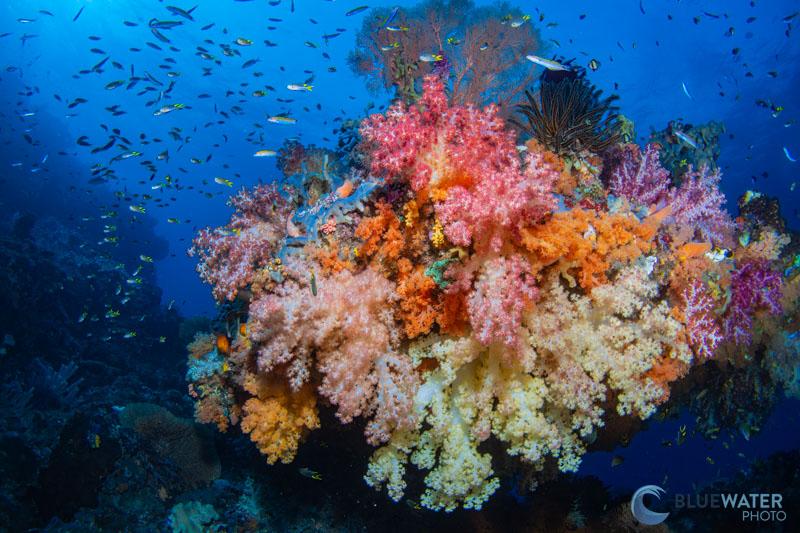
Beautiful soft corals at Four Kings, Misool photographed with the Sony A7R V in an Ikelite A7R V housing, Canon 8-15mm fisheye lens, Sigma MC-11 adapter, and dual Ikelite DS 230 strobes. f/16, 1/125, ISO 320
Sony A7R V Key Features
Build Quality, Ergonomics, & Battery Life
Sony has come a long way from the days of ergonomics infamy. In fact, the Sony A7R V has quickly become one of my favorite cameras ever designed when it comes to ergonomics, customization options, and menu design. Dare I say, I even prefer the design to my personal Nikon Z6 or the Canon R5. While the body may feel a little blockier to hold than a Nikon or Canon camera, button and dial layout is what really matters.
The A7R V uses essentially the same body as the Sony A7 IV. In fact, some housings will be compatible with both cameras (contact us at sales@bluewaterphotostore.com for compatibility information). My favorite features of this newer body design are the new video to photo mode switch underneath the mode dial and the three dial design for controlling ISO, shutter speed, and aperture independently. The new switch makes it extremely easy to switch between taking photos and videos - eliminating the need to spin the mode dial all the way around until you get to video mode.
The A7R V also has a plethora of customizable buttons - from the dedicated C1-C4 buttons to many of the buttons that are assigned out of the box. Check out our Sony A7R V underwater settings article to learn our recommended settings and customizations for underwater photo & video.
The new Sony menu system is a massive upgrade from the A7R IV. In fact, for me personally, I think the upgrade to the Sony A7R V is worth it if only for the menu system. The design of the menu layout is now vertical instead of horizontal, and color coded - much like Nikon. Many of the descriptions have been improved and make much more sense to they every day photographer.
When it comes to battery life, the Sony A7R V is rated for 530 shots when using the LCD. In practice I found this was enough for a full day of diving (about 4 dives). I didn't carry a spare battery during the trip and did not feel a need to.
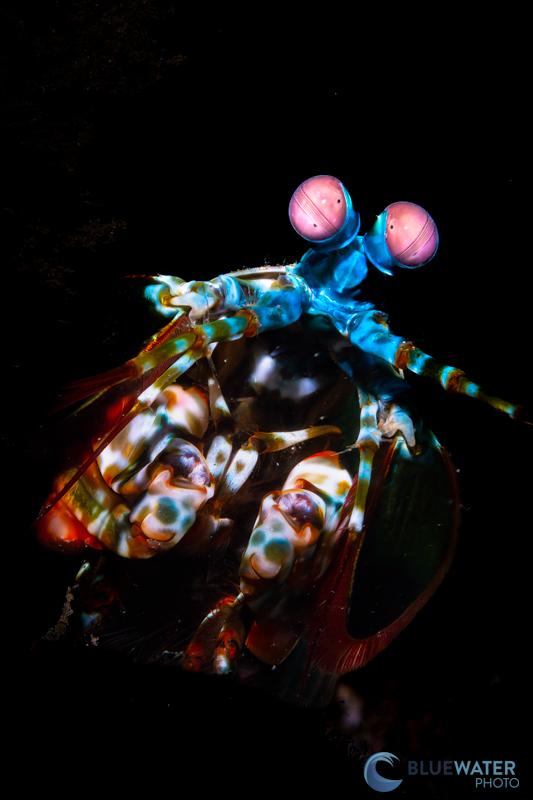
These beautiful colors on a peacock mantis shrimp were captured with the Sony A7R V in an Ikelite A7R V housing with a Sony 90mm macro lens and the Marelux SOFT Pro snoot.
61 Megapixels of Pure, Unrelenting Resolution
At 61 megapixels, the Sony A7R V is the highest resolution full-frame camera in the world. Now don't get me wrong - this isn't exactly a new feature. The sensor in the A7R V is the same sensor found in the A7R IV. This means you're met with all the same benefits and drawbacks of packing so many pixels onto a full-frame, 35mm space.
With even more resolution than the flagship Sony A1, the Sony A7R V is a delight for underwater macro photography. You can crop....and crop.... and crop and never really worry about a file that is too small for printing. In fact, the RAW files themselves are about 130 Mb each! Now having that much detail is a huge benefit if you want to print very large prints. But it can also be a hinderance as you need lot of space to carry all that data. I typically find myself using up 1 TB on a 10 day liveaboard trip.
Take a look at this 100% crop test below of a lady bug amphipod. Even using a Sony 90mm macro lens with a stacked Kraken +13 diopter, I didn't have enough magnification to capture my subject. But once I added a 100% crop, the A7R V made up for my lack of appropriate gear.
Sony A7R V 100% Crop Test

Original 61 megapixel photo of a ladybug amphipod in a tunicate
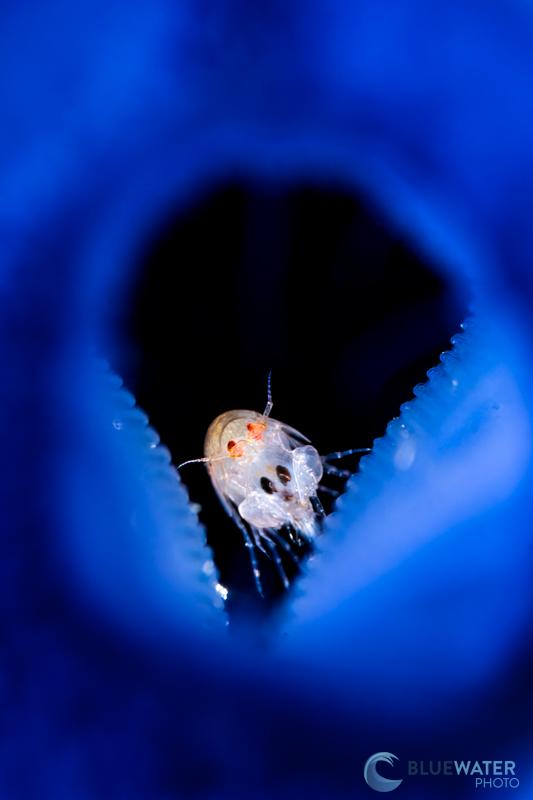
100% Crop
Resolution Considerations & Drawbacks
There are few important considerations to make when considering such a high resolution camera for a future purchase. The first is that the size of the sensor itself is not changing - it's still a full-frame sensor. This means that each of your pixels are going to be smaller, resulting in more noise at higher ISOs. While I was still able to push the sensor higher than most photographers need, the images do get fairly noisy about ISO 1250. That said, because the noise has a fine grain to it, it's fairly easy to remove in Lightroom.
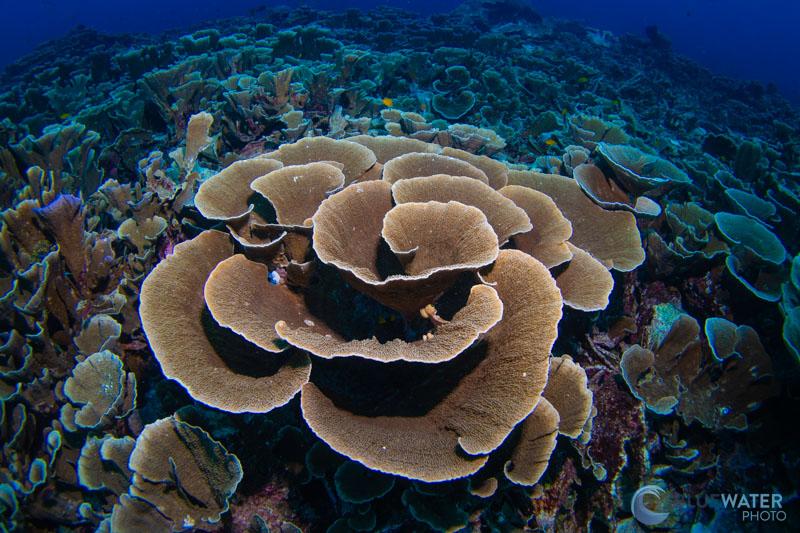
This photo of a coral garden at Melissa's Garden was only possible by raising the ISO to 800. The image was still fairly clean at that ISO. 1/80, f/14, ISO 800
Another important consideration is that the more you can crop and zoom into a photo, the more perfect that image needs to be to reap the benefits. That means it's a good idea to shoot at higher shutter speeds and smaller apertures than you would with a lower resolution camera to ensure that you are getting the best possible details in your image.
Better In-Body Image Stabilization
In-Body Image Stabilization is a feature in most mirrorless cameras that is analogous to putting your camera sensor on a gyroscope. It allows the camera to micro adjust the sensor to match movements from the camera, improving the sharpness of your images. 5-axis in-body image stabilization (IBIS) has improved drastically from 5.5 stops of correction in the A7R IV to 8 stops of correction in the A7R V. This makes the Sony A7R V more inline with the performance of the Canon R5, with smooth movement when shooting video and crisper photos as lower shutter speeds. Sony's update to the A7R V's IBIS system contributes to what I believe are sharper photos at equivalent shutter speeds than photos I captured with the Sony a7R IV.
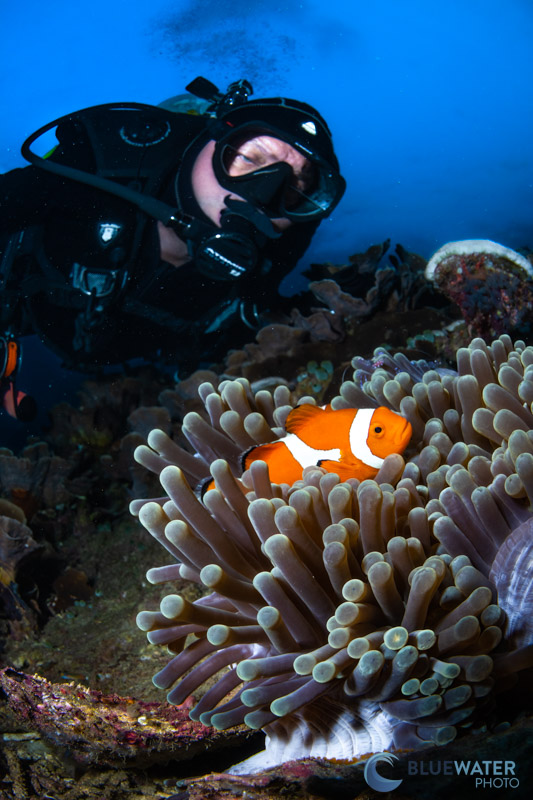
This photo was made possible by the Sony A7R V's IBIS system which allowed me to lower the shutter speed to 1/80 and still get a crisp shot. Photographed with the Sony a7R V, Ikelite A7R V housing, Canon 8-15mm fisheye lens, Sigma MC 11 adapter, and dual Ikelite DS 230 strobes. 1/80, f/18, ISO 400
Improved Autofocus with an AI Autofocus Processor
Every year, it's hard to fathom how Sony manages to make their autofocus even better, but they did it again! This time by adding a new, dedicated AI autofocus processor. While I was skeptical at first that the autofocus on the A7R V would be any different from the Sony A1 or the Sony a7 IV, I was happy to see that there have been improvements. I was able to compare the autofocus system of a Sony A7R IV we had on board to my A7R V and there was a noticeable difference in the stickiness of autofocus tracking as well as autofocus acquisition speed. Unless you are an action photographer, however, I'm not sure if it would warrant an upgrade as the autofocus performance of the Sony a7R IV is still very good.
When compared to more recent models like the Sony a7 IV and the Sony A1, the A7R V is more refined. There are a series of features available in the camera that you can play around with that allow you to select left eye vs right eye or even feed your camera images to learn from. The animal eye autofocus tracking system is better at finding fish eyes and selecting them, though I still believe recent Canon cameras are more capable at finding the eyes of underwater subjects.
Overall, there was never a point in my trip that I felt like I was missing shots due to autofocus issues - even when shooting with the Canon 8-15mm fisheye and the Sigma MC-11 adapter. In the past, I have had extreme difficulties shooting this combination, but now I believe third party lenses with the Sigma MC-11 can have acceptable autofocus. Native lenses, of course are lighting fast. The Sony 90mm with the Sony A7R V was one of the fastest macro combinations I've had the pleasure of shooting.
On this review, I decided to almost exclusively use the autofocus tracking system as it's the best AF system for controlling your autofocus point while recomposing your shot. To activate tracking, go to AF-C for your autofocus setting and then select the autofocus setting farthest down in the autofocus area menu. I find that my success rate with autofocus tracking far outweighs my success rate when shooting autofocus single, unless my subject is not moving.

The Sony A7R V's autofocus system had no problem tracking quick schools of fish amongst the soft corals of Raja Ampat. Photographed with the Sony a7R V, Ikelite A7R V housing, Canon 8-15mm fisheye lens, Sigma MC-11 adapter, and dual Ikelite DS 230 strobes. 1/200, f/18, ISO 400
Sony A7R V for Underwater Photography
The Sony A7R V is a powerhouse for underwater photography. With improvements over the A7R IV in IBIS, it's now easier to get sharper photos and take advantage of a whopping 61 megapixels of resolution. While the image quality is not different from its predecessor, macro photographers can take full advantage of an unprecedented ability to crop photos. Those who are looking to make huge prints with a lot of detail will not be disappointed.
And perhaps more importantly, the A7R V is equipped with the world's best autofocus system and a dedicated AI autofocus processor that makes it extremely easy to get tack sharp photos of the right subject for you composition.
Even though a burst rate of A7R V is "slow" by modern standards at 10 fps, most would consider it to be fast enough for underwater strobe photography, as most strobes would not be able to keep up with that recycle time. That said, the A7R V is likely not the best camera choice for quick action, pelagic photographers who are not using strobes. This is partly due to other cameras having higher burst rates and partly due to higher noise at high ISOs.
After diving with the A7R V for a couple weeks, I personally felt the ergonomics, image quality, and autofocus system made the A7R V just as fun to shoot as any other high end camera on the market like the Canon EOS R5 and the Sony A1.
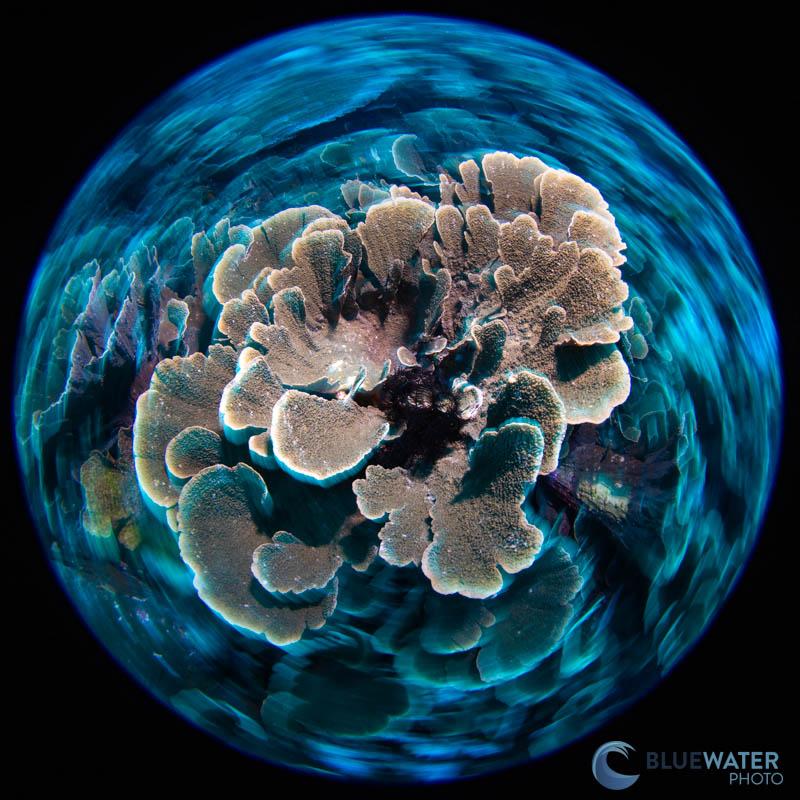
I decided to get a little creative with the Sony A7R V, Canon 8-15mm fisheye lens @8mm, Ikelite DS 230 strobes, and some slow shutter speed photography. 1/8, f/14, ISO 250
Sony A7R V for Underwater Video
A series of new video features make the A7R V a much more compelling camera over the A7R IV for video shooters. Although a high resolution sensor is not usually optimal for underwater video, the A7R V is capable of 8K/24p video. This allows underwater macro shooters to crop in their video and export in 4K or HD, as long as they keep their footage stable.
Speaking of stability, the new IBIS system built into the A7R V is excellent. It's even enough stabilization to shoot handheld video with the Sony 90mm macro. Being able to film at 4K/60p also helps videographers stabilize their video as it allows one to slow the clip in post production, reducing overall movement. There is a slight 1.24x crop in 4K/60p mode but there is technically no limit to recording times in 4K and I did not run into overheating issues on my dives. I shot in 4K/60p when filming most my video so that I could get as much stability as possible.
The A7R V also allows video shooters to use the newer S-Cinetone picture profile as well as record 16-bit RAW video to an external recorder. While I still prefer shooting in S-Log3 for an easier workflow than RAW recording but a wide range of flexibility, it is nice to have more recording options for different workflows.
Although the A7R V would not be my camera of choice for a dedicated video shooter, it certainly makes the A7R V an effective hybrid camera for serious stills photographers that also want to shoot high quality video.
Who Should Buy the Sony A7R V?
The Sony A7R V is an ideal camera for photographers that need and want a lot of resolution. It's a camera for croppers and printers and professionals. If you're the kind of photographer that wants some nice photos for Facebook and social media, the Sony A7 IV or Canon EOS R6 Mark II might be a better choice.
The A7R V is a great option for would-be photo-oriented Sony A1 shooters. If you don't need the video quality of the Sony A1 and you want to save $2600, the Sony A7R V is a much better value for money for photo shooters.
Now that said, I personally don't think most Sony A7R IV photographers need to upgrade to the Sony A7R V. With image quality being almost exactly the same, the main reason to upgrade from the A7R IV is to take advantage of improvements in autofocus. And while they are noticeable, they are not hugely different in practice. On the other hand, if you are at Sony A7R IV shooter and are considering getting into underwater video, the Sony A7R V is definitely worth the upgrade. It has many more features than the Sony A7R IV, including frame rates that are essential for underwater video - like 4K/60p.
Finally, many Canon shooters are going to be wondering if the Sony A7R V rivals the popular Canon EOS R5. In my opinion, it does. I found the A7R V to be just as pleasant to shoot underwater with incredible image quality that rivals the Canon EOS R5. I do think the Canon EOS R5 has a slight edge over the Sony A7R V for video shooters with better frame rates (e.g., 4K/120p). It also has a slight edge over the Sony A7R V for having better underwater lens options.
All in all, if you are looking for a professional high resolution camera, there's no other camera on the market with higher resolution and better autofocus.
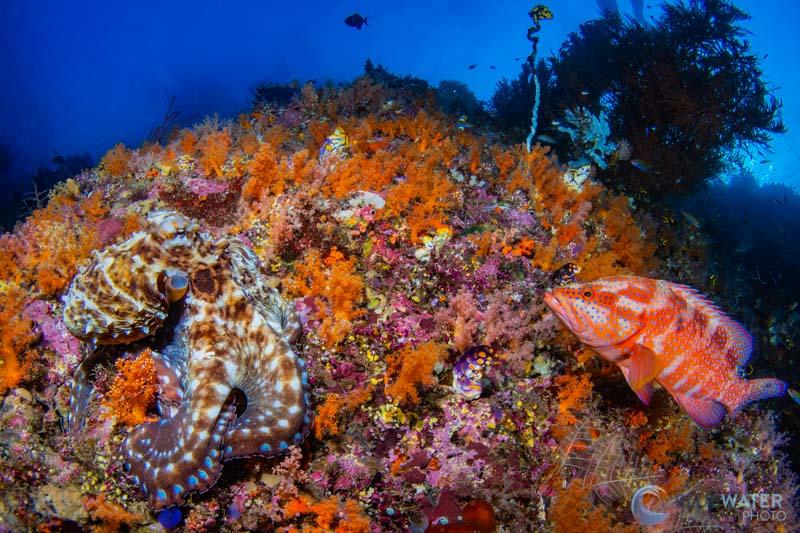
An octopus and coral grouper photographed with the Sony A7R V, Ikelite A7R V underwater housing, Canon 8-15mm fisheye lens, Sigma MC-11 adapter, and dual Ikelite DS 230 strobes. 1/200, f/16, ISO 640
Sony A7R V Underwater Housings
To our pleasant surprise, we've been able to offer a wide selection of Sony A7R V housings almost as soon as the camera was released! Currently there is an excellent polycarbonate housing option from Ikelite which we were able to take on our underwater photo workshop. There are also great anodized aluminum options from Marelux, Sea & Sea, and Nauticam. We are expecting aluminum housings from Aquatica and Isotta in the future as well. Finally, there is an excellent snorkel housing made by Aquatech that is available.
Check out our full Sony a7R V Underwater Housing Guide
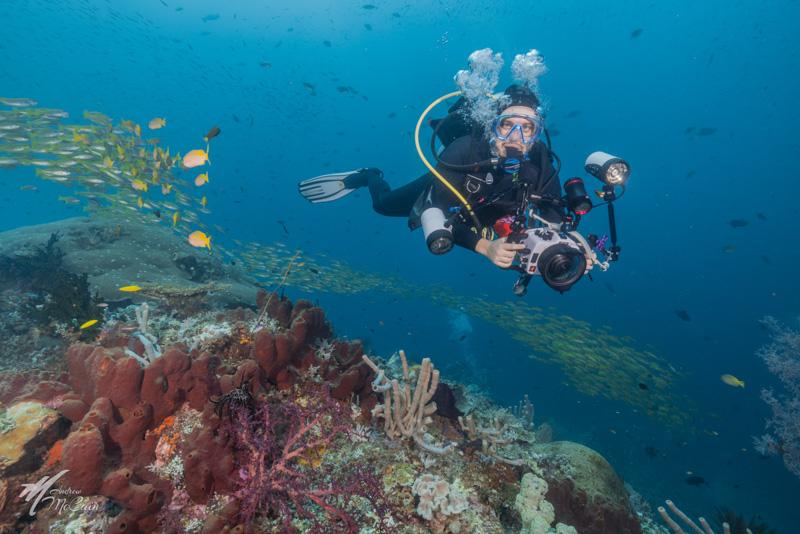
Bluewater Photo's Nirupam Nigam testing out the Ikelite Sony A7R V underwater housing in Raja Ampat. Photo by Andrew McCain
Sony A7R V: Overview of available Underwater Housings
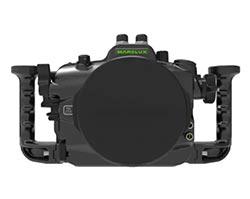
Marelux MX-A7RV Underwater Housing
With best-in class ergonomics, the Marelux MX-A7RV underwater housing underwater housing has been carefully designed to place all camera controls at your fingertips. The 125mm front port design, an industry first, allows users easy access to changing lenses with our removing the camera body from the housing. The housing construction is also what you would expect from Marelux, crafted from anodised aluminium alloy which is scratch resistant, provides sea water erosion durability and comes in a range of attractive colours.

Nauticam NA-A7RV Underwater Housing
The Nauticam NA-A7RV underwater housing underwater housing continues Nauticam's range of superbly designs housing, with great ergonomics, fingertip access to all required controls in a rugged and reliable aluminium underwater housing. Built around the N120 Port System, the NA-A7RV supports a wide range of lens options, from wide angle to macro. The housing also comes pre-installed with the patented Vacuum Check and Leak Detection system, giving you the full peace of mind your camera is safe while underwater. The NA-A7RV also fits the Sony A7RIV camera body.
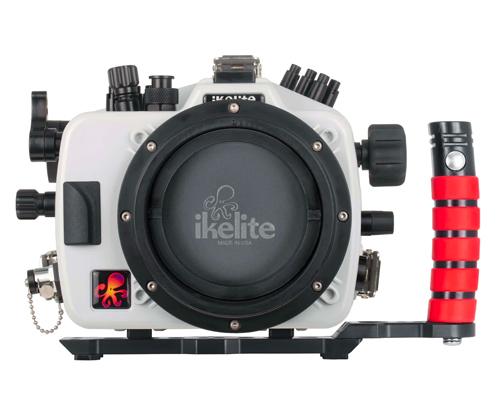
Ikelite 200DL Underwater Housing
The Ikelite A7R V 200DL underwater housing is unique in the range of housings in that it is contracted from specially formulated ABS-PC polycarbonate blend, making it durable yet light, easy to transport, and immune from corrosions, a problem with some aluminium designs. The secondary spin-off from the polycarbonate design is cost and affordability, making Ikelite housings one of the most affordable on the market. The third benefit of the polycarbonate design is the clear back which allows you to see inside the housing, should anything untoward happen underwater. However, included with the housing is Ikelite’s vacuum lock system, together with the ability to see the o-ring seal (utilising their signature open-groove design) the chance of any water damage to your camera happening is slight.
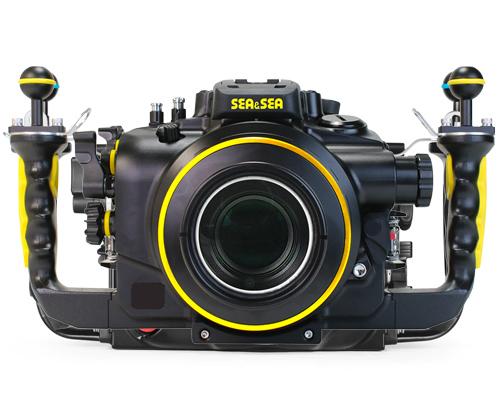
Sea & Sea MDX-A7RV Underwater Housing
The Sea & Sea MDX-A7RV underwater housing offers revised ergonomics with a keen new design and layout, with improved safety features and a colourful exterior design. These new housings offer more standard features to ensure better handling and improved protection for your camera while underwater. The new silicone handles provide better grip, while new SA8 fixed ball bases come standard with the housing. The new Leak Alarm Unit comes standard with new housings, and with the larger rear window, one has better feeling of what is happening inside your housing.
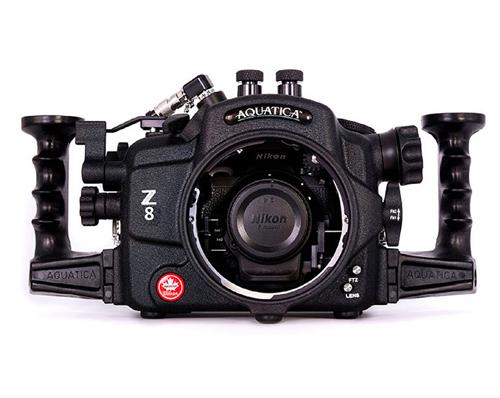
Aquatica A7RV Underwater Housing
The Aquatica A7RV underwater housing underwater housings are know for their ruggedness, built to last, while still offering all the functionality required to create incredible underwater imagery. The housing is one of the smallest on the market. Crafted from anodised aluminium with a powder coating paint makes it extremely resistant to scratches. The new housings come fitted with their proven Surveyor Vacuum System, providing added protection for your camera underwater. They are also compatible with many flash triggers and sync chords, making them versatile and customisable.
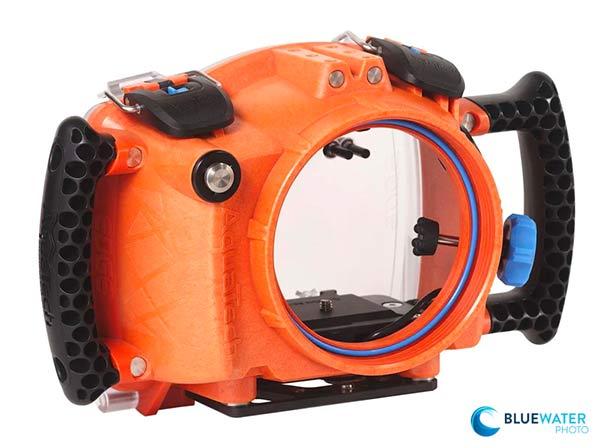
Aquatech EDGE Pro Water Housing for Sony A7RV
Aquatech EDGE Pro for Sony A7RV is a lightweight and compactly designed, one of Aquatech’s most advanced and ergonomic housing, constructed from polycarbonate, with stainless steel controls, these housings have been crafted since 1998 for all discerning surf and ocean photographers. With their convenient pistol grips to allow easier handling in the water, these housings have been a favourite for over 20 years. With a depth rating of 10m (33ft), they are not meant for diving, but more for water-sports and surface photography.
Sony A7R V Underwater Lenses
Best Wide-Angle Lenses
With improvements in autofocus with the Sony A7R V, I now believe the Canon 8-15mm fisheye lens with the Sigma MC-11 adapter is the fisheye option for most wide angle shooters. I found the autofocus to be effective, though not as fast as a Sony native lens.
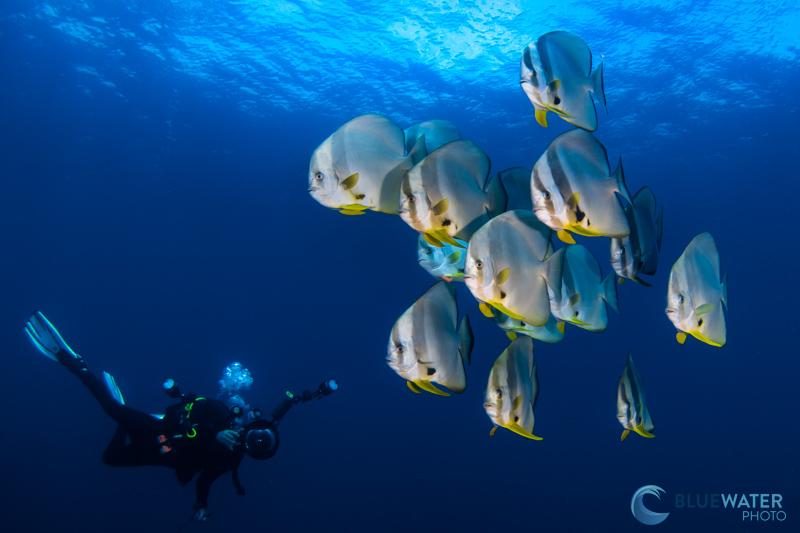
Sony A7R V photo taken with the Canon 8-15mm fisheye lens with the Sigma MC-11 adapter
For both photo and video, the Sony 16-35mm F4 lens with an 8-inch dome or larger is an excellent choice. There are also some great wet wide-angle lenses available such as the Nauticam wet wide-angle lens or the Kraken KRL-01 wet wide-angle lens that can be used with the Sony 28mm prime lens. The Sony 28mm prime lens also works well with a fisheye conversion lens to capture even wider shots of large reefscapes.
If you're looking for the most versatile wide-angle Sony set up for underwater shooting, the Sony FE 28-60mm F4-F5.6 lens behind a flat port with zoom capability paired with the Nauticam WWL-1B Wide-Angle Wet lens is the way to go. The downside is that it's currently only compatible with Nauticam and Marelux housings. Check out the Underwater Photography Guide's article about the Sony FE 28-60mm F4-F5.6 lens for more information or email us at sales@bluewaterphotostore.com to get set up with this combination.
Best Mid-Range Lenses
The Sony 28-70mm F3.5-F5.6, the Sony 24-70mm F4 and the Sony 35mm F2.8 portrait lens are three good mid-range options.
Best Macro Lenses
There are two native Sony lenses that we think are great macro options: the Sony 90mm and 50mm macro. The 90mm has a faster autofocus motor, but if you need to get a little more in your composition, the 50mm macro does an ok job. Recently, we reviewed the Sigma 105mm f/2.8 DN DG Art macro lens. It's an excellent and more affordable option to the Sony 90mm with better image quality. However, it is not a great choice for video due to focus breathing. We already mentioned the Sony FE 28-60mm F4-F5.6 lens and how it makes a great wide-angle option when used with a wide-angle wet lens, but combine it with the Nauticam Compact Macro Converter CMC-2, and it becomes a very versatile and highly capable macro set up too.
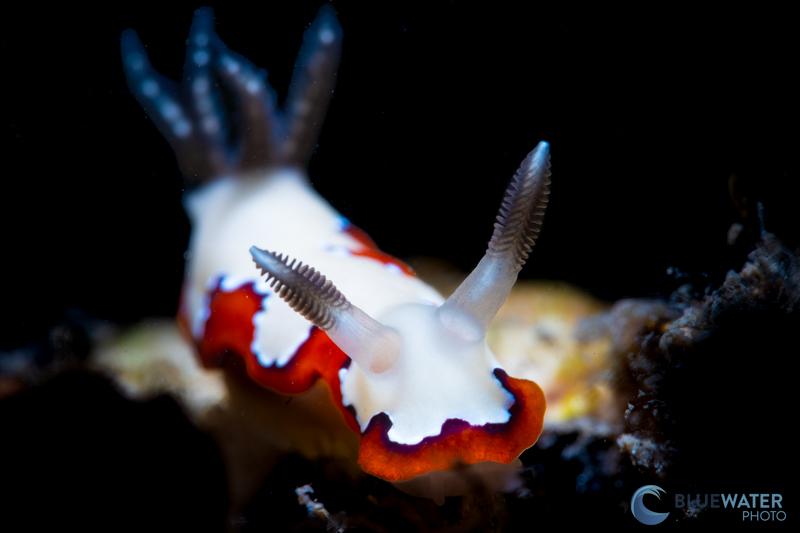
Sony A7R V photo captured with the Sony 90mm macro lens
Canon Lenses for the Sony A7R V
Canon lenses can be attached to the Sony A7R V with the Metabones, Sigma MC-11, or Photodiox adapters, but auto-focus is generally better with Sony lenses. Lenses like the Canon 8-15mm, 16-35mm, 17-40mm, and 100mm can work well. I found that the Canon 8-15mm fisheye lens worked better with the Sigma MC-11 adapter than with the metabones adapter.
Conclusions
At the end of my adventures in Indonesia, I found myself much more pleased with the experience of shooting the Sony a7R V than I expected. While the camera is not a huge upgrade from the original Sony A7R IV, it represents an affordable professional model at a much better value than the Sony A1, rivaling the Canon R5. The A7R V is a solid tool for any underwater creative, and you'd be hard pressed to find someone that needs more from a camera. With more resolution than any full frame camera in the world, the A7R V opens up another dimension in cropping and printing. And when every pixel needs to be perfect at high resolutions, the A7R V offers an autofocus system and IBIS system to back it up. Ultimately, I returned home happy with a hard drive full of vibrant color, incredible details, and some nice video clips to top it off.
